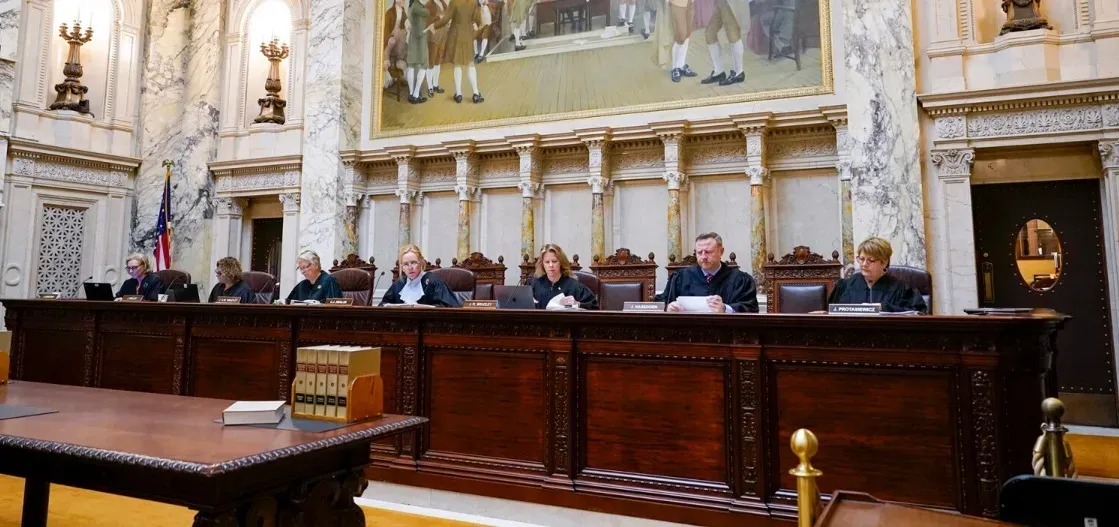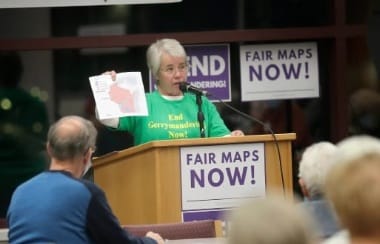Maps groups now take aim at Congressional maps, possible independent commission
Democrats have won every statewide race but three over the past seven years, but hold just 2 of 8 House seats

Until Janet Protasiewicz won her election in 2023 and turned the Wisconsin Supreme Court from a 4-3 conservative to a 4-3 progressive majority, there was little chance to bring an end to the partisan gerrymandering that had landed Republicans unbreachable majorities in the state legislature.
The GOP had successfully convinced the supreme court in 2021 that the new maps proposed by Gov. Evers’ People’s Maps Commission – which undeniably would have created significantly greater proportional representation in the legislature – produced too much disruption for the voters and that least change to the maps in place since 2011 should be the guiding principle in the courts’ decision. The courts thus adopted the legislature’s least-changed district maps on those grounds.
The trouble with that argument was, there is nothing in the Wisconsin constitution that addresses least change as a rationale for changing or not changing district maps. Furthermore, that rationale was riven with hypocrisy given that the GOP’s own redrawing of those maps in 2011 created an even larger disruption to the maps and resulted in Wisconsin becoming the most gerrymandered state in the country.
In other words, least change was not anywhere on the GOP’s radar when it drew their maps in 2011, using computer models that entrenched the greatest possible advantage for Republicans and rendering it all but impossible that the Democrats could ever enjoy a majority again.
Hypocrisy, though, has no legal standing when it comes to challenges to the law.
Now the Congressional maps are being challenged
With the tipping of the court in 2023, though, the state legislative maps finally were changed just ahead of the 2024 election. The elimination of the highly partisan maps resulted in the Democrats closing the gap in the state senate from a 11-seat to 3-seat GOP majority and in the assembly from a whopping 29-seat to just a 9-seat GOP advantage.
What didn’t change at the time but what will soon likely come before the state supreme court were the Congressional maps – those maps which determine our state’s US House members. Those maps were themselves drastically redrawn by the GOP in 2011, resulting this past election in a 6-2 GOP majority, despite the fact the statewide electorate is a near 50-50 split between Democrats and Republicans.

Democrats, in fact, have won every statewide race but three over the past seven years, narrowly losing one senate and two presidential elections but capturing the presidential election once, the governorship twice, the attorney general’s seat twice, another US senate seat twice and two supreme court races in landslides.
Every 10 years the state must redraw district maps to account for population shifts and movement. The legislature and governor must agree on these new maps or the court ultimately decides. In 2011 the Republicans held the assembly, the senate and the governorship, allowing them to enact their highly partisan maps. Gov. Evers’ vetoed the GOP’s maps in 2021 when the courts ultimately adopted least change to keep those maps in place.
Now, several lawsuits have been filed with the Wisconsin Supreme Court challenging the Wisconsin congressional districts as unconstitutional on a couple of grounds: 1) that Republicans have enjoyed a significant advantage in the state’s congressional districts despite a near-even partisan split statewide; and 2) that malapportionment of Wisconsin’s Congressional map fail to give voters equal representation. Specifically, the suit alleges that among the state’s eight congressional districts, there are too many voters in some and too few in others and thus do not fall within constitutional guidelines.
Courts are more likely to look at unequal representation
The second part of this lawsuit also challenges the constitutionality of the Republicans’ least change rationale for keeping the maps as they are.
Penny Bernard Schaber, who is a team leader on the 8th Congressional District’s Fair Maps Team, says the first grounds may prove too vague for the court to take up.
“I think they’re going to look at them both,” says Bernard Schaber, who served three terms in the state assembly but lost in her bid for state senate in 2014. “You can say that it’s clear the maps have given the Republicans an advantage. But whereas a partisan gerrymander can be seen, is it provable?”
More likely, she says, the court will take up something that is much more objectively measurable: Does the lack of proportional populations among the eight congressional districts violate the Voting Rights Act? Article IV, Section 3 of the state constitution mandates representation based on the number of inhabitants within each district though it allows for deviations to account for such things as maintaining “communities of interest” (people with common specific interests should as much as possible be kept together). It further suggests that the ‘One Person, One Vote’ principle established by the US Supreme Court obliges the state to maintain equal population among congressional districts.
Bernard Schaber anticipates the Republicans holding to their least change argument to urge the court to maintain the current district maps.
“They’re going to say, yeah, we didn’t want voters to have to deal with too many changes,” she speculates. “So they’re going to try to make it sound like they did it for the voters versus doing it to maintain their own winnable and undefeatable majority.”
If the courts end up ruling in favor of the plaintiffs and determine either that the least change argument is invalid based on it not being in the constitution or that the districts are malapportioned and must be redrawn, the congressional maps will revert to the state legislature to try again to meet constitutional guidelines. Bernard Schaber holds out hope that the much narrower advantage the GOP legislators now hold would make them much more inclined to find common ground with the Democrats and fairer maps would be the yield.
“So the opportunity for some agreement and some cooperation is high and would hopefully happen,” she says.
Her concern is twofold: that the majority leadership – in this case, Robin Vos – has shown little tendency to play ball with Democrats and that the 2015 campaign finance laws make it a lot easier for assembly and senate campaign committees to put financial pressure on legislators to not cooperate with the opposition.
Just as in the state legislative maps case from earlier this year, if the governor and the legislature could not agree on new congressional maps, the courts would ultimately step in and decide which maps best pass constitutional muster. In the matter of the legislative maps, Republicans accepted Gov. Evers’ maps for fear that the Supreme Court would draw maps that they considered worse for their party.
The same scenario might play out in this case.
The push for an independent redistricting commission
While those lawsuits go forward, the Wisconsin Fair Maps Coalition is joining forces with the League of Women Voters of Wisconsin and the Wisconsin Democracy Campaign to draft a proposal for legislation to create an Independent Redistricting Commission.
“We are getting close to a final draft legislative proposal,” Bernard Schaber said. “Our proposal is currently being vetted by experts connected to the Campaign Legal Center (CLC) which has done a tremendous amount of work on redistricting commissions. The committee is almost ready to take our work to the next step which would include introducing it to our activists and supporters and the public.”
Currently four states use independent commissions to draw maps, while five others use bi-partisan political commissions. The idea of the commissions is to remove partisan, conflicted individuals – legislators themselves, especially – from the redistricting process so as to render more representative government.
The ultimate goal is to enshrine the Independent Redistricting Commission (IRC) into the state constitution. Several steps lead to that goal: first to enact it into law through the legislature; then, for a majority of both the Assembly and the Senate to vote for a proposed constitutional amendment in two consecutive legislative sessions; and only then to put the amendment on the general election ballot for the voters to pass or reject.
Under the group’s plan, the commission would consist of fewer than 20 people, divided equally among Democrats, Republicans and individuals unaffiliated with either party. A designated state service agency would select from a large group of applicants to assure geographical distribution and equal representation in the IRC.
Wisconsin voters are ready, Bernard Schaber thinks
Under the Fair Maps Coalition proposed, the IRC would draw maps based on specific non-partisan parameters, taking into account the Voting Rights Act, the state constitution and communities of interest, while making certain there would be no artificially created partisan leans nor consideration for a district’s previous voting history.
Two-thirds of the commission would need to approve of any map before it was submitted for the legislature’s approval or rejection. If the legislature rejects the commission’s map three times, it is proposed that the Wisconsin Supreme Court would draw the maps.
The bottom line: the legislature could not draw the maps, only reject or approve those drawn by the IRC.
Bernard Schaber emphasises that the idea of the commission is not to create equal outcomes, just fairer and more impartial and constitutionally sound processes for drawing maps. She recognizes that the urban/rural divide wherein Democrats are more densely packed into fewer geographical areas such as Milwaukee, Madison and city centers might always provide the GOP a built-in advantage.
“But if the maps are drawn in a fashion that meet very specific geograhpic and demographic parameters and not partisan parameters, I think it can be balanced so it’s less of a built-in majority,” she said. “It’s a majority where you actually have to work with each other.”
Bernard Schaber thinks the Wisconsin people are ready to take partisanship out of district map drawing, that they understand the toxic effects of gerrymandering and are ready for a non-partisan commission.
“Because we’ve done so much work to educate the public on how harmful this has been to our state, I would hope that, one, we could get the legislature to pass an independent redistricting commission,” she said. “And two, to get the legislators to pass it twice and get it onto the general ballot to make it a constitutional amendment.”






